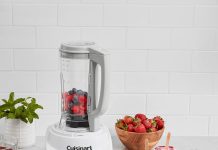Have you ever wondered if you can juice citrus fruits without removing the rind using a masticating juicer? Well, the answer is not as straightforward as you might think. In this article, we’ll explore the possibilities and limitations of juicing citrus fruits with their rinds intact using a masticating juicer. So grab yourself a refreshing glass of orange juice and let’s find out if you can skip the peeling process!
Review contents
Can I Juice Citrus Fruits Without Removing The Rind With A Masticating Juicer?
Citrus fruits are a popular addition to many diets due to their refreshing taste and high vitamin C content. When it comes to juicing these fruits, one common question arises: can I juice citrus fruits without removing the rind using a masticating juicer? In this comprehensive article, we will delve into the world of masticating juicers, explore the benefits they offer, discuss the challenges of juicing citrus fruits with the rind, suggest possible methods to overcome these challenges, share tips for juicing citrus fruits with the rind, and explore alternative ways to use citrus rind. But first, let’s understand what masticating juicers are and how they work.
Understanding Masticating Juicers
Definition of Masticating Juicers
Masticating juicers, also known as slow juicers or cold press juicers, are a type of juicer that use a rotating auger or gear to crush and squeeze fruits, vegetables, and other ingredients to extract the juice. Unlike centrifugal juicers, which use high-speed spinning blades, masticating juicers operate at slower speeds, resulting in a higher juice yield and better nutrient retention.
Working Mechanism
The working mechanism of masticating juicers involves a two-step process. First, the produce is fed into the machine through a tube, where it is crushed by the rotating auger or gear. This crushing action breaks down the cell walls of the fruits and vegetables, releasing the juice. The second step involves the juice being separated from the pulp through a screen or filter, resulting in a smooth and pulp-free juice.
Types of Masticating Juicers
There are two main types of masticating juicers: horizontal and vertical. Horizontal masticating juicers have a longer and narrower design, with the auger placed horizontally. They are ideal for juicing leafy greens, wheatgrass, and other fibrous ingredients. Vertical masticating juicers, on the other hand, have a more compact design, with the auger placed vertically. They are versatile and can handle a wide range of fruits and vegetables, including citrus fruits.
Benefits of Using a Masticating Juicer
Masticating juicers offer several benefits that make them an excellent choice for juicing citrus fruits and other produce. Let’s explore these benefits in detail.
Higher Nutrient Retention
One of the main advantages of using a masticating juicer is its ability to retain a higher percentage of nutrients compared to other juicer types. The slow speed and gentle crushing action of a masticating juicer help minimize heat and oxidation, both of which can degrade the nutritional value of the juice. As a result, you can enjoy a glass of citrus juice that is bursting with vitamins and minerals.
Less Oxidation
Oxidation, caused by exposure to air, is a common issue when juicing fruits and vegetables. It can lead to a loss of color, flavor, and nutrients in the juice. Masticating juicers, with their slow and gentle extraction process, minimize oxidation and help preserve the quality of the juice. This means your citrus juice will be fresher and more vibrant for longer periods.
Greater Juice Yield
One of the frustrations when juicing citrus fruits is not getting enough juice from each fruit. Masticating juicers excel in extracting every last drop of juice from your citrus fruits. The slow and thorough extraction process ensures maximum juice yield, so you can get the most out of your fruits.
Versatility
While masticating juicers excel at juicing citrus fruits, they are not limited to just that. These versatile machines can handle a wide variety of fruits, vegetables, leafy greens, and even nuts and seeds. This means you can experiment with different combinations and flavors to create delicious and nutritious juices.
Challenges of Juicing Citrus Fruits with Rind
Juicing citrus fruits with the rind poses a unique set of challenges. While the rind can add flavor and nutrients to the juice, it can also introduce bitterness, affect digestion, and concentrate certain compounds. Let’s explore these challenges in more detail.
Bitterness from the Pith
The pith, which is the white spongy layer between the rind and the fruit, can add bitterness to the juice. This bitterness can be overpowering and unpleasant. Removing the rind before juicing helps minimize the presence of pith and ensures a more enjoyable citrus juice experience.
Difficulty in Digestion
The rind of citrus fruits contains high amounts of fiber, which can be difficult for some individuals to digest. While the pulp in most juices is strained out, the presence of rind fibers can still pose challenges. Individuals with digestive issues or sensitivities may find it more comfortable to juice citrus fruits without the rind.
Higher Concentration of Certain Compounds
Citrus rinds contain essential oils and compounds such as limonene that contribute to their distinct aroma and flavor. While these compounds are generally safe to consume in moderation, the concentration can become higher when the rind is included in the juice. Some individuals may find the flavor overpowering or experience adverse reactions to these compounds.
Effect on Flavor
While adding the rind to the juicer may enhance the flavor of the juice by adding citrusy notes, it can also introduce bitterness or an unpleasant taste. The flavor of the rind varies depending on the fruit and its ripeness. Experimentation is key to finding the right balance and determining personal preferences when juicing citrus fruits with the rind.
Possible Methods to Juice Citrus Fruits with Rind
While the challenges of juicing citrus fruits with the rind are apparent, there are several methods you can try to overcome them. Let’s explore these methods together.
Using a High-Powered Masticating Juicer
Some high-powered masticating juicers, specifically designed for citrus fruits, can handle juicing citrus fruits with the rind. These juicers are equipped with powerful motors and specialized mechanisms that can efficiently extract the juice while minimizing the bitter flavor from the rind. If you are determined to juice citrus fruits with the rind, investing in a high-powered masticating juicer is worth considering.
Blending and Straining Method
If you don’t have a juicer capable of handling citrus fruits with the rind, you can opt for the blending and straining method. Start by thoroughly washing the citrus fruits, then cut them into chunks and remove any visible seeds. Place the chunks in a blender and blend until smooth. Once blended, strain the mixture using a fine-mesh strainer or cheesecloth, separating the juice from the pulp and rind fibers. This method requires some additional effort but can yield a smooth and pulp-free citrus juice.
Freezing and Thawing Technique
Another method to juice citrus fruits with the rind involves freezing and thawing the fruits beforehand. Start by washing the citrus fruits, then place them in a sealed bag or container and freeze overnight. Once frozen, remove the fruits from the freezer and allow them to thaw at room temperature for a few hours. The thawing process softens the rind, making it easier to juice along with the fruit. Once thawed, juice the citrus fruits using a masticating juicer or the blending and straining method mentioned earlier.
Experimenting with Masticating Juicers
When it comes to juicing citrus fruits with the rind using a masticating juicer, some experimentation may be required to achieve the desired results. Here are a few tips to help you along the way.
Selecting the Right Masticating Juicer
Not all masticating juicers are created equal, and some may be better suited for juicing citrus fruits with the rind than others. Look for high-powered masticating juicers with specialized citrus attachments or features designed to handle the rind. Reading reviews and seeking recommendations can help you find the right juicer for your needs.
Adjusting Juicing Speed and Pressure
Even without a specialized citrus attachment, you can experiment with adjusting the juicing speed and pressure on your masticating juicer. Trying different combinations of speed and pressure can help optimize extraction and reduce the bitterness from the rind. Start with a slow speed and gradually increase the pressure until you find the right balance.
Testing Different Citrus Fruits
Different citrus fruits may have varying results when juiced with the rind. Some fruits may produce a pleasant flavor profile, while others may taste overly bitter or strong. To find your personal preferences, experiment with different citrus fruits and observe the taste, aroma, and texture of the resulting juice. It’s all about discovering what you enjoy most!
Tips for Juicing Citrus Fruits with Rind
If you decide to explore juicing citrus fruits with the rind using a masticating juicer, here are some helpful tips to consider.
Choosing Organic Citrus Fruits
Opting for organic citrus fruits ensures that you’re avoiding unnecessary exposure to pesticides or other harmful chemicals. The rinds of non-organic fruits may contain higher levels of pesticide residue, which can be transferred to the juice during the extraction process. Organic options provide peace of mind and a healthier juicing experience.
Thoroughly Washing the Fruits
Before juicing citrus fruits with the rind, it is crucial to thoroughly wash them under running water. This removes any surface dirt, bacteria, or residue that may be present. Use a gentle vegetable brush to scrub the rind, ensuring that it is clean and ready for juicing.
Preparing the Citrus Fruits
To prepare the citrus fruits for juicing, start by cutting them into manageable chunks or slices. This makes it easier to insert them into the juicer and ensures a more efficient extraction process. Remove any visible seeds or blemishes from the fruit as well.
Slicing Techniques
Experimenting with different slicing techniques can impact the overall taste and texture of the juice. For a milder, less bitter flavor, consider removing the pith from the slices before juicing. You can also try various slicing styles, such as thin slices or thicker wedges, to see how they affect the outcome.
Peel Removal Options
If you prefer a smoother and pulp-free juice, you can choose to remove the rind before juicing. A sharp knife or a citrus peeler can help you easily separate the fruit from the rind. Alternatively, you can partially peel the fruit, leaving strips of rind intact for added flavor and nutrients.
Alternative Ways to Use Citrus Rind
While juicing citrus fruits with the rind may not be suitable for everyone, there are alternative ways to put citrus rind to good use. Here are a few suggestions.
Adding Zest to Recipes
Citrus zest, the colorful outer layer of the rind, is full of flavorful essential oils and can elevate the taste of many recipes. Grate or finely chop the zest and add it to baked goods, marinades, dressings, or even cocktails for an extra burst of citrusy goodness.
Making Infused Water
Infused water is a refreshing and healthy way to enjoy the flavors of citrus fruits. Simply slice the citrus fruits, including the rind, and add them to a pitcher of water. Let the fruits infuse the water for a few hours or overnight in the refrigerator, and you’ll have a delicious and hydrating beverage.
Creating Homemade Cleaners
The natural acidity and essential oils present in citrus rinds make them a great ingredient for homemade cleaners. You can make a citrus-infused cleaner by soaking the rinds in vinegar for a few weeks, then strain the mixture and use it as an all-purpose cleaner for various surfaces in your home.
Crafting Natural Air Fresheners
Instead of using synthetic air fresheners, why not make your own natural ones using citrus rinds? Place the rinds in a pot of water, add some spices or herbs like cinnamon or lavender, and simmer on low heat. The steam will release a refreshing aroma, making your home smell clean and inviting.
Safety Considerations
As with any food-related process, there are safety considerations to keep in mind when juicing citrus fruits with the rind.
Pesticide Residue
If you choose not to buy organic citrus fruits or cannot access them, be aware of the potential presence of pesticide residue on the rind. Thoroughly washing the fruits can help minimize the exposure, but it’s important to weigh the risks and make an informed decision.
Food Allergies
While citrus fruits are not common allergens, it’s essential to be aware of any personal or family history of allergies. Some individuals may be allergic to citrus fruits or experience sensitivity to the compounds present in the rind. If you or someone in your household has known allergies, consult with a healthcare professional before juicing citrus fruits with the rind.
Potential Contamination
Fruits, including citrus fruits, can harbor bacteria or other contaminants on their surface. Washing the fruits thoroughly is necessary to reduce the risk of contamination. Additionally, proper hygiene practices, such as washing your hands and cleaning the juicer after each use, should be followed to maintain a safe and healthy juicing environment.
Conclusion
In conclusion, while juicing citrus fruits without removing the rind using a masticating juicer presents unique challenges, it is possible with the right techniques and considerations. Masticating juicers offer several benefits, including higher nutrient retention, less oxidation, greater juice yield, and versatility. However, the bitterness from the pith, difficulty in digestion, higher concentration of certain compounds, and impact on flavor must be taken into account. Various methods like using a high-powered juicer, blending and straining, or freezing and thawing can help overcome these challenges. Experimentation with different fruits, adjusting juicing speed, and pressure can further enhance the juicing experience. Remember to follow safety considerations, explore alternative ways to use citrus rind, and most importantly, find the right balance that suits your taste preferences. With the versatility of masticating juicers, you can enjoy the nutritional benefits and refreshing flavors of citrus fruits, with or without the rind. Happy juicing!
































